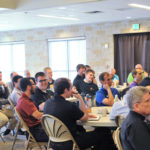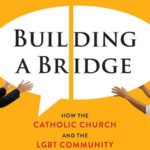By Barb Arland-Fye
Editor

In procession, families with young children and families with teens, couples and individual adults, approached the front of the sanctuary to venerate the crucifix on Good Friday with a tenderness that moved me.
My husband Steve, our son Colin and I had front-row seats for the service in my parents’ parish. The worshippers, who represented a wide swath of ages, stood or knelt, some with difficulty but determination, and kissed or touched the body of Christ. One older man gently placed his hand on Jesus’ head and lingered in contemplation.
For two hours in that sacred space, political beliefs and the issues of the day were set aside. Our gratitude for Jesus’ self-sacrificing love reinforced our common bond as sisters and brothers. Our Savior died for us and we allowed that reality to absorb our attention. I left the church with a deeper appreciation for the meaning of Good Friday. Love builds faith.
On Easter Sunday morning, the presiding priest reflected on the Gospel reading (John 20:1-9) and its message that love builds faith. Mary of Magdala, a devoted follower of Jesus who witnessed his crucifixion and burial, returns to the tomb in the early morning hours before dawn and discovers that his body is not there. “So she ran and went to Simon Peter and to the other disciple whom Jesus loved, and told them, ‘They have taken the Lord from the tomb, and we don’t where they put him.’”
The Beloved Disciple and Simon Peter race to the tomb, with John arriving first. He sees the burial cloths but does not enter the tomb. Simon Peter enters the tomb and sees the burial cloths and the cloth that had covered Jesus’ head. He “saw and believed,” but the two disciples “did not yet understand the Scripture that he had risen from the dead.”
The “Workbook for Lectors, Gospel Readers and Proclaimers of the Word (2023)” describes Mary Magdalene, Peter and the Beloved Disciple as “persons of limited faith at this point.” However, in the verses that follow (John 20:11-18, which are not part of the Easter Sunday Gospel), Mary Magdalene encounters someone she mistakes for the gardener until he identifies himself as Jesus. When “he calls her by name, she recognizes him to be the risen Christ,” who sends her to deliver a message to the disciples, proclaiming, “I have seen the Lord.” She is the first apostle of the resurrection, one of the workbook’s authors says.
Our presider for that Easter Sunday Mass views the latter Gospel passage as evidence that love builds faith. Mary Magdalene’s loving relationship with Jesus made her receptive to faith. The presider encouraged his congregation to have the faith of Mary Magdalene by building on a loving relationship with Jesus.
I was struck by the example our presider set in his loving demeanor throughout Mass. His warmth as he prayed, sang, preached, consecrated and distributed the Eucharist made a lasting impression. One indelible example: a young mother approached the priest to receive Communion. She held a little girl in her arms who was cuddling a baby doll in her arms. The priest gave Communion to the mom. Then he gently touched the little girl’s head for a blessing followed by a blessing for the baby doll. The expression on the faces of mother and daughter afterwards were a ripple effect of the message that love builds faith.
(Contact Editor Barb Arland-Fye at arland-fye@davenportdiocese.org)











